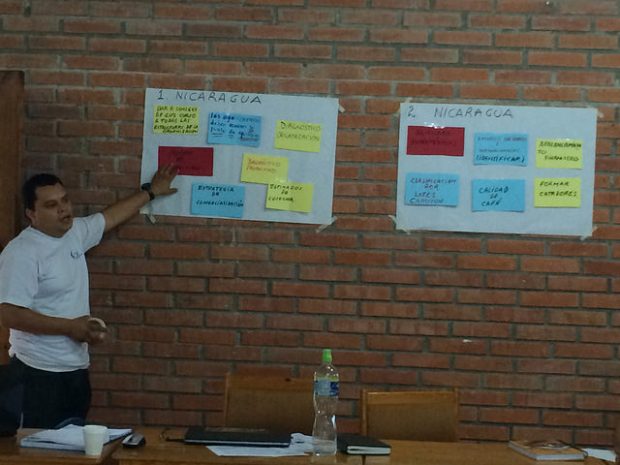
Jimmy Chavarria of CRS Nicaragua walks through priorities for participating Nicaraguan cooperatives. Photo by CRS.
If you have been following this blog, you may have seen a series of posts on price risk management and its increasing importance in collectively developing a more sustainable sector that protects actors throughout the coffee supply chain.
I’ve been writing about this topic for the past nine months and talking about it for even longer. Finally, this last week, I got to walk the walk.
With the help of the amazing Sara Morrocchi, formerly of the green coffee trading company Sustainable Harvest, CRS Coffeelands put together our own course on PRM that starts at the very beginning and moves through increasing levels of complexity.
First, we need to understand what risk is, and where and how each cooperative faces it, with a special focus on price risk. Then we explore how you can mitigate price risk through physical strategies (collecting most of your coffee before you sell it), then through the use of more sophisticated financial tools, like futures contracts and options. Much of the prior work and emphasis in this area has been on the use of options.
That’s how we drew up the course, but reality is always a bit different. This training showed us more precisely what areas our cooperatives are struggling with.
For every financially sophisticated cooperative such as SOPPEXCCA, COOPETARRAZU, COOPERANDES or Chirinos that understands and uses advanced PRM tools, there must be 10 or 20 cooperatives out there that aren’t ready to buy options or to set up variable sales contracts. These cooperatives might still be commercializing their coffee in parchment; they don’t even know what their fixed or variable costs are. Let me repeat that: They sell their coffee without truly knowing what their operating costs are.
Many of the success stories that do exist have had the benefit of years of public support and funding invested in developing organizational capacities of these cooperatives, while others continue to operate as best they can, on their own. Don’t even get me started about all of the unorganized farmers who sell to intermediaries at prices that are half of what the NYC price is — $1.35 at the time of this article — which is the greatest coffee pricing tragedy of all.
What Did We Learn?
We need to go back to the basics for many cooperatives. We need to build administrative and managerial capacities in these organizations. We need to focus on topics such as:
- What is risk? How do they face risk in buying and selling coffee?
- What is the global price of coffee today? How is it determined? How does it vary through price differentials, or where you sit on the value chain? How can the cooperative get the best possible price for the coffee it has?
- What are the operating costs of the cooperative? Which of these are fixed and which are variable? How does the volume of coffee that they commercialize affect each of these costs? Based on this, what is their break-even price, or their equilibrium point?
- What is their offer? How much coffee can they commercialize and what is the quality of this coffee?
- Who are they selling to? What type of negotiation power do they have? Are they missing opportunities to add value?
- How do you structure a contract for direct sale? How do you determine your price?
There are some emerging tools that may aid with these topics. With cellphones, one can easily check and know the global price of coffee. The SCAA has been sharing tools to be able to talk about the qualities of coffee, but we need more cuppers and Q graders at origin. The rise of online trading platforms can give cooperatives easier access to buyers in the U.S. and Europe.
But the bottom line is that there are a lot of cooperatives who lack even the most basic tools to be profitable businesses and who are commercializing their coffee at a fraction of the FOB price. These are the cooperatives and farmers that need our attention and need who investment in their capacities in order to become the market links we need them to be.
Kraig Kraft
Kraig Kraft is the CRS Technical Advisor for Coffee and Cacao for the Latin America/Caribbean. He is Based in Managua.
Comment
1 Comment
Comments are closed.






Great input,
I have read some of Kraig’s previous articles related to coffee price and risk associated issues for producers particularly small farm holders and coffee farmers cooperatives.
It’s encouraging to see people like Kraft working on the ground with the coffee farming communities in daily bases, and brings to our attention the severe deficiencies of Skill and Capital to match the most sophisticated western buyers in the global marketplace.
Thank you Kraig.